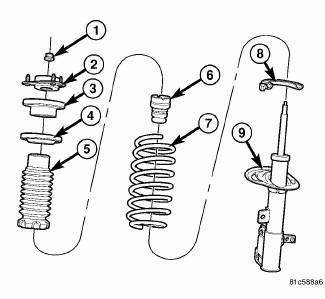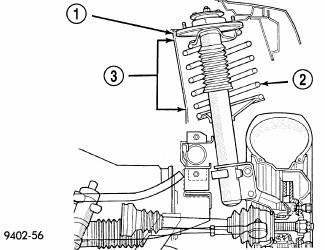Dodge Journey: Diagnosis and Testing
STRUT ASSEMBLY

Fig. 80: Strut Assembly (Exploded)
Inspect the strut assembly for the following conditions:
- Inspect for a damaged or broken coil spring (7).
- Inspect for a torn or damaged dust shield (5).
- Inspect for torn or deteriorated spring isolators (4, 8).
- Lift the dust shield and inspect the strut assembly for evidence of fluid running from the upper end of the strut fluid reservoir. (Actual leakage will be a stream of fluid running down the side and dripping off lower end of unit). A slight amount of seepage between the strut shaft and strut shaft seal is not unusual and does not affect performance of the strut assembly.
- Inspect the jounce bumper (6) for signs of damage or deterioration.
- Inspect the clearance between the shock tower and the coil spring. Make sure no fasteners are protruding through the shock tower possibly contacting the coil spring and strut. Because of the minimum clearance in this area, installation of metal fasteners could damage the coil spring coating and lead to a corrosion failure of the spring.

Fig. 81: Shock Tower Area (Typical)
CAUTION: At no time when servicing a vehicle can a sheet metal screw, bolt or other metal fastener be installed into the strut tower (1) to take the place of an original plastic clip. Also, do not drill holes into the front strut tower for the installation of any metal fasteners into the shock tower area indicated (3).
 Description, Operation
Description, Operation
DESCRIPTION
A Macpherson type design strut assembly is used in place of the traditional
front suspension upper control arm
and upper ball joint. The bottom of the strut mounts directly to the stee ...
 Removal
Removal
1. Remove the engine appearance cover.
Fig. 82: Cowl Top Screen
2. Remove the two push-pins (1) securing the cowl top screen at the ends.
Remove the remaining push-pins
(2). Remove the cowl top ...
See also:
Installation
Fig. 101: Check For Stretched Bolts
- STRETCHED BOLT
- THREADS ARE NOT STRAIGHT ON LINE
- THREADS ARE STRAIGHT ON LINE
- UNSTRETCHED BOLT
NOTE: The cylinder head bolts (4) are tighte ...
Task manager
Description
The PCM is responsible for efficiently coordinating the operation of all the
emissions-related components. The
PCM is also responsible for determining if the diagnostic systems are ope ...
Description, Operation
DESCRIPTION
There are two unique park brake switches used on this vehicle, depending upon
whether the vehicle has a foot-operated or hand-operated park brake lever
mechanism.
FOOT-OPERATED
Fi ...
